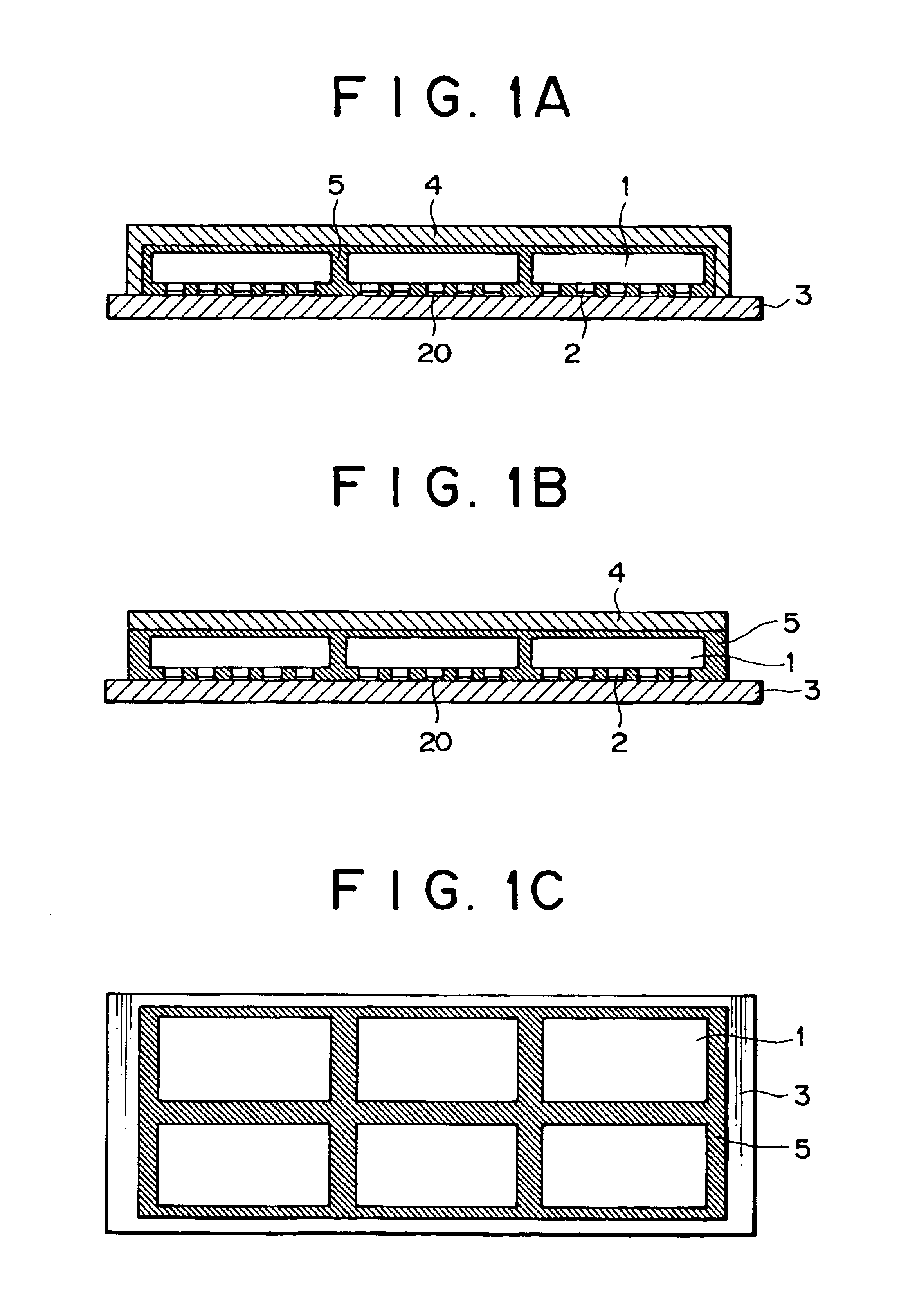Semiconductor module and mounting method for same
a technology of semiconductor modules and mounting methods, which is applied in the direction of semiconductor devices, semiconductor/solid-state device details, electrical apparatus, etc., can solve the problems of difficult transmission of heat generated in each chip to the wiring board, prone to cracking of the bonded end face between the stressed chip and the heat spread cap, and high cost, etc., to achieve high heat resistance and high reliability. , the effect of low cos
- Summary
- Abstract
- Description
- Claims
- Application Information
AI Technical Summary
Benefits of technology
Problems solved by technology
Method used
Image
Examples
embodiments 1
[0053]FIGS. 1A and 1B are sectional views of semiconductor modules wherein six semiconductor chips 1 are mounted on one side of a wiring board 3 with use of metal bumps 2, upper surfaces of the semiconductor chips are covered with a heat spread plate 4, and a resin composition 5 is filled between the wiring board and the heat spread plate. FIG. 1C is a top view without the heat spread plate.
[0054]In the module shown in FIG. 1A, both ends of the heat spread plate 4 are bent to afford a cap shape, with end faces of the cap being bonded to the wiring board. On the other hand, in the module shown in FIG. 1B, the heat spread plate is formed in a flat plate shape. A comparison of the two shows that the module illustrated in FIG. 1A is superior in point of heat spreading characteristic. The semiconductor chips 1 may be bare chips or may be semiconductor packages such as CSPs. Though not shown in the drawing, one end of the metal bumps 2 is electrically connected to pads of the bare chips a...
embodiments 2
[0061]FIG. 2A is a sectional view of a semiconductor module wherein six semiconductor chips 1 are mounted on one side of a wiring board 3 by a metal wire bonding method and FIG. 2B is a top view thereof without a heat spread plate. The six semiconductor chips 1 are sealed by a resin composition 5 together with metal wires 6. A mounting method for this semiconductor module will be described below with reference to FIGS. 6A to 6F.
[0062]First, semiconductor chips 1 are mounted on a wiring board 3 with use of an insulative adhesive as in FIG. 6A. Preferably, the adhesive is an epoxy resin adhesive having a low elastic modulus which is 1 Gpa or lower at room temperature. Then, pads 21 formed on a circuit-formed side of each semiconductor chip 1 and pads 20 formed on the wiring board 3 are connected together using metal wires 6 as in FIG. 6B. Next, a resin composition 5 is put on each semiconductor chip as in FIG. 6C. Thereafter, as shown in FIG. 6D, a heat spread plate 4 is put on the re...
embodiment 3
[0065]FIG. 3 shows a semiconductor module wherein a plurality of semiconductor chips 1 are mounted on one side of a wiring board 3 with use of metal bumps 2. The semiconductor chips 1 and a heat spread plate 4 are bonded together using an adhesive 7, and a resin composition 5 is filled around the plural semiconductor chips. A mounting method for the semiconductor module of this structure will be described below with reference to FIGS. 7A to 7H.
[0066]First, as shown in FIG. 7A semiconductor chips 1 having metal bumps 2 and a wiring board 3 are provided. Next, as shown in FIG. 7B metal bumps 2 are connected to pads 20 formed on the wiring board 3. In FIGS. 7B et seq. the illustration of the pads 20 is omitted. Next, an adhesive superior in thermal conductivity is applied onto upper surfaces of the semiconductor chips 1 as in FIG. 7C. Preferably, the adhesive 7 is in the shape of a sheet. For this embodiment, an epoxy resin, a silicone resin, an acrylate or a methacrylate is suitable a...
PUM
 Login to View More
Login to View More Abstract
Description
Claims
Application Information
 Login to View More
Login to View More - R&D
- Intellectual Property
- Life Sciences
- Materials
- Tech Scout
- Unparalleled Data Quality
- Higher Quality Content
- 60% Fewer Hallucinations
Browse by: Latest US Patents, China's latest patents, Technical Efficacy Thesaurus, Application Domain, Technology Topic, Popular Technical Reports.
© 2025 PatSnap. All rights reserved.Legal|Privacy policy|Modern Slavery Act Transparency Statement|Sitemap|About US| Contact US: help@patsnap.com



